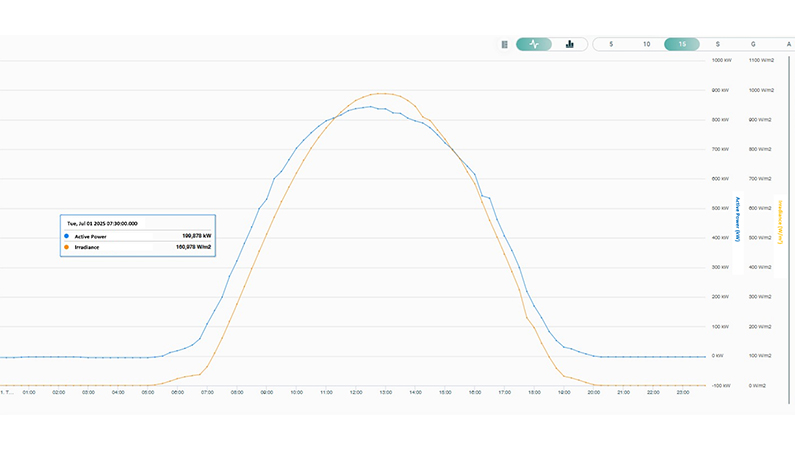In order to achieve the main objective of installing a Photovoltaic (PV) Plant, which is generating efficient solar energy, it is crucial to calculate correctly its Performance Ratio. In fact, investing in a solar plant without being able to accurately monitor its performance can lead to a wasted time and money.
What is the Performance Ratio of PV Plant?
The Performance Ratio (PR) is the key indicator used to check the PV Plant’s efficiency and effectiveness. The PR is simply calculated by comparing the actual energy output of the system to its expected energy output under specific conditions. In simple terms, it indicates whether the PV Plant is performing as expected or no.
Why is the PR important?
Running a PV Plant without knowing its PR may generate serious losses in energy. In fact, without regular PR monitoring, the PV Plant may generate less energy than expected without noticing it.
In addition, the PR is one of the main metrics used to take decisions concerning the maintenance planning of a PV Plant. By identifying the anomalies in PR data, it becomes easy to address issues, optimize the performance and ensure a long-term effective investment in renewable energy.
The Formula for Calculating Performance Ratio
The PR is essentially a measure of how well your solar plant is converting sunlight into usable electricity.
To calculate the Performance Ratio, you can use the basic formula as follows:

Actual Energy Output refers to the total energy in kWh generated by the PV Plant. This data is obtained from the inverters which records the actual production of the solar panels in a defined period.
Expected Energy Output refers to the theorical energy the PV plant should produce under the actual environmental conditions. This data is calculated using the Solar Irradiance received by the PV Plant.
Solar Irradiance received by the PV Plant during the same period is measured and sourced from Weather Station including the Irradiance Sensor or Pyranometer. It is used to calculate the maximum possible energy Output.
PR as per IEC61724-1 Standard
According the international standard IEC61724-1:2021, The performance ratio PR is the quotient of the system’s final yield Yf to its reference yield Yr, and indicates the overall effect of losses on the system. The PR formula is as follows:

Where;
- Eout: Energy Output from PV System (AC) [kWh]
- P0: Installed nominal (DC) power capacity of the PV system [kWp]
- Hi: In Plane Irradiance [kWh/m2]
- Gi,ref: Reference irradiance (typically 1000 W/m²)
Expanding the above formula gives:

Where;
- Pout,k: AC power output of the PV plant at time interval k [kW]
- τk: Duration of the time interval k [h]
- Gi,k: Plane-of-array irradiance measured at interval [W/m²]
- ∑k: Summation over all time intervals in the reporting period
PR is calculated based only on measured irradiance and neglecting other factors over the given reporting period:

Examples of calculating the PR of a PV Plant
Basic Example of calculating PR
Given:
- Actual Energy Output = 4,500 kWh
- Expected Energy Output = 6,000 kWh
(calculated from irradiance)
Calculation:
![]()
Result:
The Performance Ratio of the PV system is 75%, meaning the system delivered 75% of its theoretically possible energy under the given solar irradiance conditions.
Advanced Example of calculating PR
Suppose we are monitoring a 100 kWp PV system (P0=100) and we collect data at three 15-minute intervals (τk=0.25 hours).
We have the following data:
| Interval k | Pout,k [kW] | Gi,k [W/m²] | τk [h] |
| 1 | 60 | 800 | 0,25 |
| 2 | 70 | 900 | 0,25 |
| 3 | 50 | 700 | 0,25 |
Assume:
- Gi,ref =1000 W/m²

=> PR = 75%
Result:
The Performance Ratio over these three intervals is 75%, indicating the system is operating at 75% of its theoretical potential, normalized to irradiance conditions.
Interpretation of PR of a PV Plant
Interpreting the Performance Ratio (PR) of a PV plant is just as important as its calculation. Generally, a PR above 80% refers to a healthy PV Plant, while a lower PR is a sign of anomalies to be fixed in the PV Plant.
In case the PR is higher than 100%, this usually means that the used sensors are not compatible with the PV Plant. For example, in a bifacial PV plant, using only one irradiance sensor will ignore rear-side generation, potentially aaffecting the PR. In such cases, an albedometer should be used.
Similarly, if it is a dual oriented PV plant and only a single irradiance sensor is used, the PR calculation will be wrong resulting in very high or very low PR values. A dual-orientation irradiance setup is required for accurate monitoring in this case.
